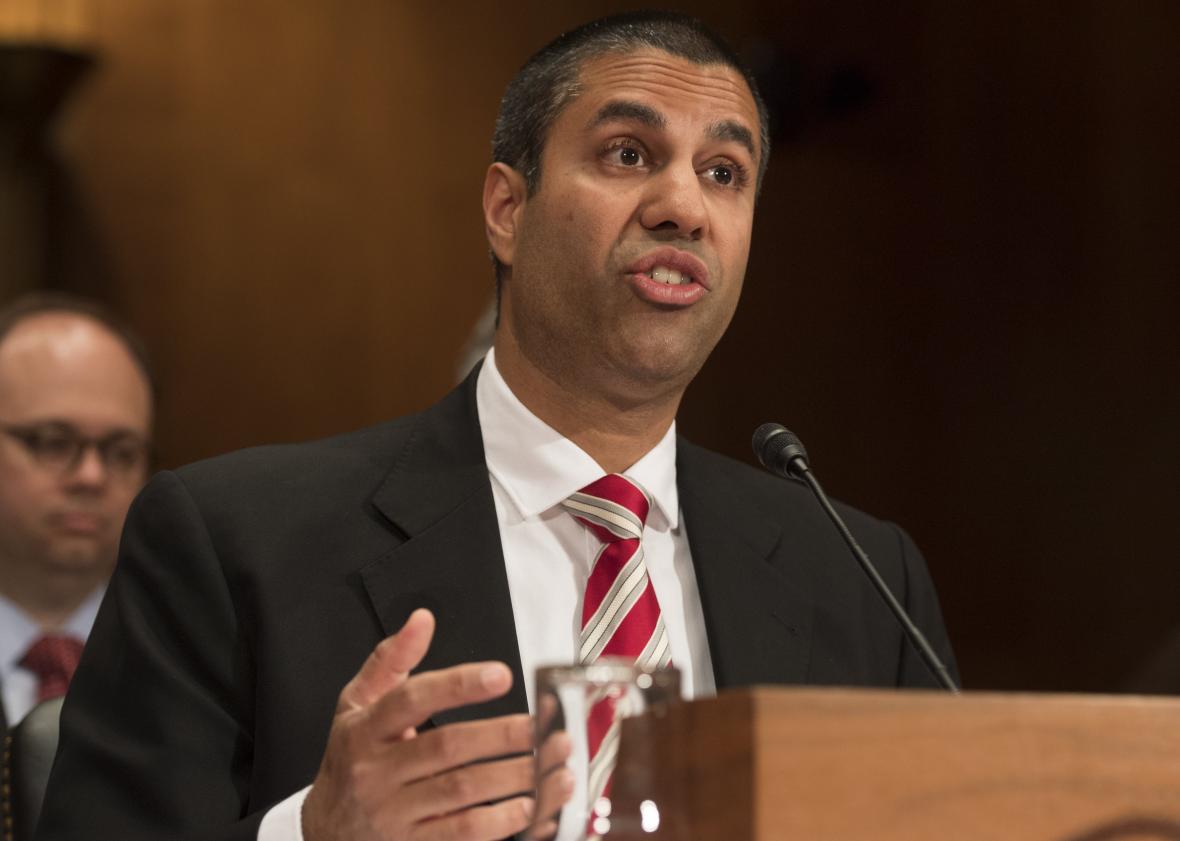If Trump’s Federal Communications Commission has its way, the internet of the future is probably going to look a lot like the internet of today—and that’s a bad thing. New websites and innovative startups will have a hard time finding an audience without network neutrality protections––the rules that prohibit internet providers from speeding up access to some websites and not others.
Ajit Pai, the current chairman of the FCC, is laser-focused on, as he eloquently put it late last year, “taking a weed whacker” to the network neutrality framework—known as the open internet rules—that the FCC passed in 2015 under President Obama. He’s already started whacking away. In May, Pai introduced a new proposal that would undo the Obama-era net neutrality rules, which the current Republican-led FCC could vote on by the end of the year.
On Tuesday, a House subcommittee held a hearing to discuss the future of the FCC and where its plans to unravel open internet protections are headed next. And Republicans at the hearing wasted no time backing Pai’s plan to rescind the open internet rules.
“Chairman Pai, we hope you’re keeping that ‘weed whacker’ handy because it has a lot of work to do,” Rep. Marsha Blackburn, a Republican from Tennessee, said in her opening remarks.
Pai’s proposal to undo the open internet rules argues that net neutrality has dissuaded internet providers, like Comcast, Verizon, and AT&T, from investing in building out and upgrading their networks. Likewise, at the congressional hearing, Pai said that a convincing argument that investment in internet infrastructure actually was on the rise could persuade him to stop trying to roll back net neutrality protections .
The problem with this argument, though, is that according to the internet providers themselves, investment in their networks actually has gone up since the net neutrality rules were passed.
In the first quarter of 2017, AT&T told investors it “expanded the company’s 100% fiber network powered by AT&T Fiber, which is now in parts of 52 metros with plans to reach at least 23 more metros, across the 21 states.” AT&T further pointed out that it “expects to add 2 million fiber locations in 2017.” If the 2015 network neutrality rules did dissuade infrastructure build out as Pai says, AT&T certainly didn’t get the memo.
In Comcast’s call to investors in February 2016, the telecomm noted that its increased capital spending was due to an uptick in “investment in network infrastructure to increase network capacity.”
And Verizon, too, has told investors that it continued to spend on expanding its network post-net neutrality. “In 2015, Verizon invested approximately $28 billion in spectrum licenses and capital for future network capacity,” the company said in its January 2016 investor report. In April of this year, Verizon noted that its capital spending of $3.1 billion “was largely network-related to maintain leadership in our markets.”
Small internet providers have been even more explicit about the importance of network neutrality for their success. In June more than 40 small internet providers from across the country wrote a letter to the FCC to share that none had experienced “any barriers to investment” as a result of the 2015 decision. They also shared their concerns that repealing the rules would increase the market power of large internet providers like Comcast or Verizon, making it even more difficult for smaller providers to compete.
Now, it is possible that internet providers might have invested even more without the net neutrality rules. But even if that’s true, investments may be stunted for any number of reasons, including the proposed merger between Time Warner and AT&T, the presidential election, or Verizon’s acquisition of Yahoo, to name a few. It’s unclear what kind of proof Ajit Pai needs to persuade him that network neutrality rules have not caused investment in broadband infrastructure to slump.
To support his proposal, Pai cited research claiming that capital expenditure from internet providers has gone down 5.6 percent since 2014. But that doesn’t necessarily mean net neutrality is to blame. Reducing overall spending can be a result of shifting investments and priorities at the company—and again, internet providers themselves say that they are still investing in infrastructure.
But one thing is clear: Without network neutrality rules, internet providers stand to make a whole lot of money. That’s because the companies will be able to operate what’s essentially a two-way toll, collecting money from both internet subscribers and websites that want to reach those users at faster speeds. This will inevitably put new, smaller businesses at an extreme disadvantage.
One of the great promises of the internet is that there’s no telling what someone might innovate next. The possibilities are endless––that is, unless internet providers aren’t forced to treat everyone equally.
Pai’s claims that internet providers aren’t investing in their networks is misleading, at best, and potentially ruinous for the future of a vibrant internet if his proposal to gut net neutrality rolls through unchallenged without a big public fight. And the scary thing is that in the current political climate, with so many major changes underway all at once, net neutrality may become a casualty.
